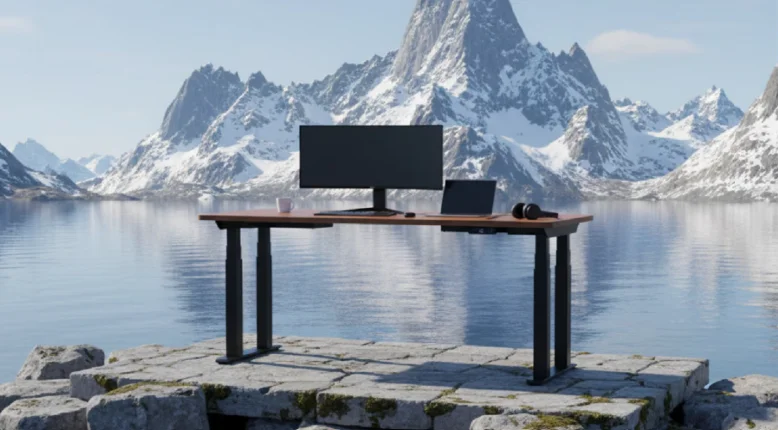Standing desks have turned the whole idea of working around because they promote movement, better posture, and productivity. Over the last few years, the development of ergonomic design has given rise to the emergence of the Large Standing Desk, addressing the particular needs of the workspace. Out of them, two-leg and four-leg standing desks can be seen as the most popular ones. Although the two have the same purpose of offering height and comfort that can be adjusted, their design, performance, and longevity are quite different. The knowledge of such distinctions can enable better decision-making of the buyers on the basis of functionality, space, and long-term usage.
History of Heavy Duty Standing Desk Designs
Standing desks are available in a variety of designs, but their functionality is based on the same principle, which is the adjustability of height, enabling users to change their sitting and standing postures during the day. The most common one is the two-leg standing desk, whose tabletop rests on two motorized or manual legs. It is highly popular in residential offices and business environments because it is very small and not very expensive.
Alternatively, the four-legged standing desk is a more recent, high-end table constructed with higher stability, strength, and balance. It has a motorized system in each foot, which means that the movement is smooth and synchronized even when the weight is heavy and not evenly distributed. Although it might be more expensive, it can be used in a professional setup where reliability and strength are required.
Balance and Stability of Structure
Stability is one of the major differences between four-leg and two-leg standing desks. Designed to be stable, two-leg desks can be a little wobbly when standing on their tallest legs- particularly when they are loaded with large monitors, desktop computers, or dual-screen systems. The stability of it consists mostly in the quality of the frame material and the accuracy of its motor synchronization.
Four-leg standing desks, such as the FlexiSpot E7 Plus Max, on the other hand, have unsurpassed stability. Their four-legged design spreads the weight more evenly and reduces the center of gravity, which makes them practically immovable even in full extension. The extra reinforced joints will also make the desk stable in its movement and hence have no shaking or vibration that might cause equipment to shake or might bother the user.
Load Capacity and Durability
The other important area of difference between the two types of desks is the load capacity. A standard two-leg standing desk is capable of supporting less than 450 pounds, which is enough to support office standard equipment. But when this capacity is surpassed, it may put a strain on the motors and may influence long-term performance.
Comparatively, a 4 legged standing desk is constructed to offer heavy-duty services, as its weight support is usually 660 pounds. This is why they are best suited to a professional who needs to have a huge configuration, such as several monitors, printers, sound systems, or special instruments. Also, the frames of four-leg desks are produced using thicker carbon steel, thus offering superior durability and strength that can be used over the years with heavy usage without bending or weakening.
Noise Level and Motion Smoothness
The quality and synchronization of motors are important in the smoothness and silence of a standing desk. Two-leg desks have two motors, one in each leg, to lift and lower the desktop. Although effective, they have different performances per load distribution.
On the other hand, four-leg desks have four motors, each equipped with a motor per leg. This not only guarantees a smooth lifting but also increases the velocity and stability of the transition. Most of the models have a noise level of less than 50 dB and can be run at approximately 1.5 inches per second without making noise, even when using shared space.

Design Adaptability and Beauty: Large Sit Stand Desk
Two-leg desks are minimalistic in design and smaller. They can be used in small offices in the home or in the study rooms where simplicity and low costs are of the essence. Most of the models provide clean lines, modern finishes, and all kinds of desk materials to suit the interior look.
On the contrary, four-legged standing desks have a premium executive feel. They come with a solid frame with a symmetrical design that adds value to larger offices or creative studios. They are typically able to support bigger desktop areas, such as one-piece solid wood or bamboo surfaces, and are thus appropriate to dual-purpose spaces, such as shared workstations or conference systems.
Safety and Smart Features
Modern ergonomic furniture largely takes safety into account. Basic safety measures included in two-leg standing desks are typically overload protection and straightforward anti-collision sensors. Although they are adequate for most home users, there are occasions when these features do not have accuracy when they are applied to uneven loads.
Four-leg standing desks, conversely, have superior anti-collision, child locks, and smart control keypads. Such systems provide the safety of users as well as equipment security. Most of the models have USB quick charges, several memory settings, and even an app-based height adjustment tracker. These smart systems are convenient and functional and are a manifestation of the continued introduction of smart technology in ergonomic office furniture.
Price and Value Consideration
The price is considered a key factor when dealing with two-leg and four-leg desks. Standing desks with two legs tend to be cheaper. Based on the quality of the materials and motor. They can be used in personal use or light office environments where there is no need to carry heavy loads.
Four-leg standing desks, such as the FlexiSpot E7 Plus Max, on the other hand, are normally priced. Although this might be considered a higher investment, the added value of this, which is increased load capacity, increased life, increased stability, and professional-level performance, is much greater in the long run. This is an investment that is economically compensated in the durability and functionality of the company or a professional looking to have a future-proof workstation.
Purchasing the Proper Home Office Desks
A decision to use a two-leg standing or a four-leg standing desk will always rely on the needs of the user. A two-legged standing desk is ideal for students, remote employees, or people with lower configurations and less space. It is flexible, economical, and cost-efficient.
However, a four-leg standing desk is designed with excellent performance, stability, and reliability in mind for professionals who require uncompromising performance and stability. Its robust design and high functionality make it fit design studios, corporate offices, or any workstation that requires exactness and robustness.
Conclusion
Although both two-leg and four-leg standing desks are beneficial in terms of posture and healthier work habits, the differences between them are in the power, stability, and durability. Two-leg desks are simple and cost-effective, whereas four-leg desks reinvent the definition of being comfortable and efficient in working with power and precision. The four-leg design is the best choice for any person in need of a large sit-stand desk that achieves both style and substance in providing the workspace with innovation, performance, and longevity.







